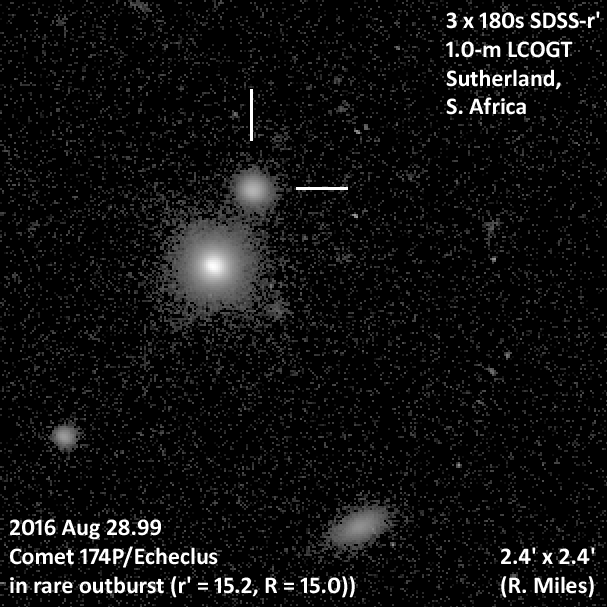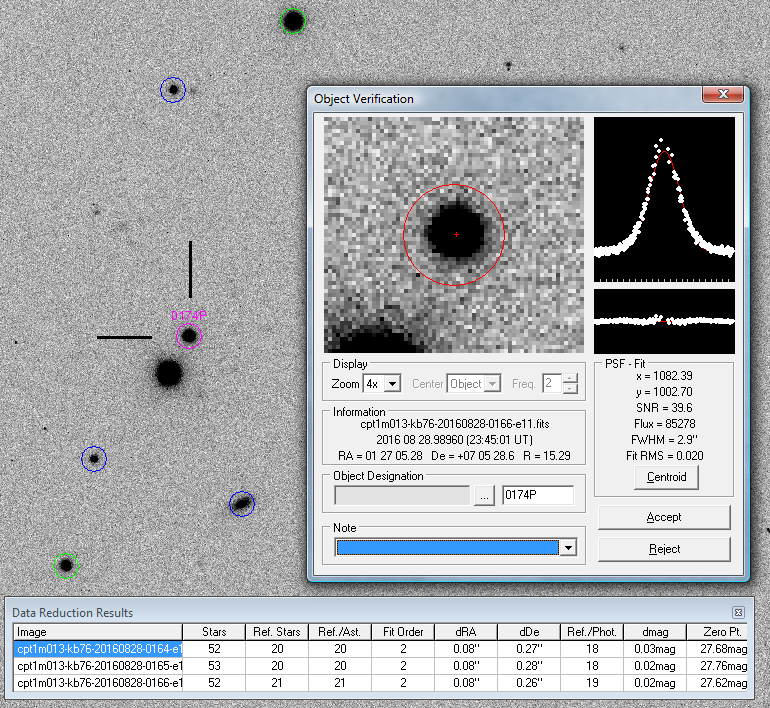2016 August 29
Rare outburst of centaur comet
When discovered in 2000, this centaur object was thought to be an asteroid: that is until it outburst in December 2005 / January 2006 and it was thereafter assigned the designation of a periodic comet, namely 174P/Echeclus. At that time, a blob of material separated from the 60-km nucleus and was subsequently observed to disintegrate over several weeks. Thanks to amateur astronomer Paul Camilleri observing from Blue Mountains Observatory, Leura, NSW, Australia, 174P has been spotted within hours of another strong outburst similar to that of 10 years ago. This is an extremely rare event in that this comet has only been seen to outburst twice in total: the other time being in May / June 2011 when it was nowhere near as bright as it is now.
Jean-François Soulier, Denis Buczynski and the writer carried out rapid follow-up observations confirming Paul’s incredible discovery. The coma is currently shining 10 times brighter than it did on August 27 and, some 24 hours after the initial event, it is entirely stellar in appearance. Here are a few images depicting it looking like a magnitude 15 star:

Here are some measurements of Paul’s discovery images:
COD Q68
COM Filter: Clear
COM Photometric aperture: 5.2″ radius
OBS P. Camilleri
MEA R. Miles
TEL 0.30-m f/5.4 Schmidt-Cassegrain + CCD
ACK MPCReport file updated 2016.08.28 22:20:00
NET UCAC-4
0174P C2016 08 27.71786 01 27 15.82 +07 07 18.5 17.76N Q68
0174P C2016 08 27.74484 01 27 15.60 +07 07 16.1 17.92N Q68
0174P C2016 08 28.68603 01 27 07.86 +07 05 55.1 15.21N Q68
0174P C2016 08 28.70610 01 27 07.68 +07 05 53.3 15.23N Q68
—– end —–
For the record, here’s an extract of astrometric and photometric measurements made using one of the Las Cumbres Global Observatory Network 1.0-m f/8 Ritchey-Chretien telescopes at Sutherland, South Africa confirming the outburst:
COD K92
COM Filter: SDSS-r’
COM Photometric aperture: 5.6″ radius
OBS R. Miles, LCOGT
MEA R. Miles
TEL 1.0-m f/8.0 Ritchey-Chretien + CCD
ACK MPCReport file updated 2016.08.28 23:56:45
AC2 rmiles@baa.u-net.com
NET UCAC-4
0174P C2016 08 28.98523 01 27 05.32 +07 05 28.8 15.27N K92
0174P C2016 08 28.98742 01 27 05.30 +07 05 28.8 15.27N K92
0174P C2016 08 28.98960 01 27 05.28 +07 05 28.6 15.29N K92
—– end —–

It is currently 16 months after perihelion some 6.27 AU from the Sun (q = 5.82 AU, Q = 15.54 AU, Period = 34.9 yr).
Observers are strongly urged to monitor the development of this most rare outburst.
Richard Miles
2016 August 29 02:20UT
| The British Astronomical Association supports amateur astronomers around the UK and the rest of the world. Find out more about the BAA or join us. |
